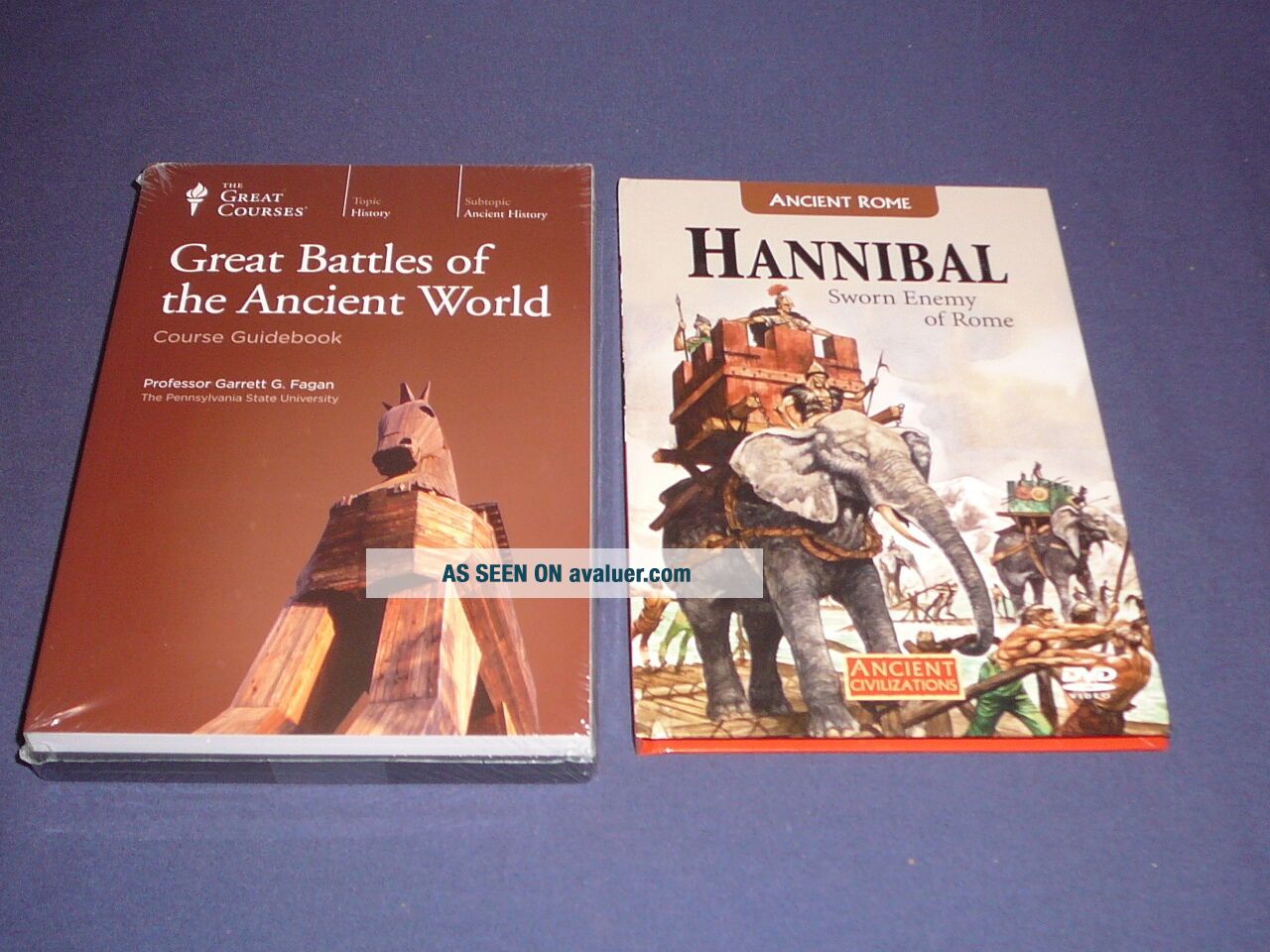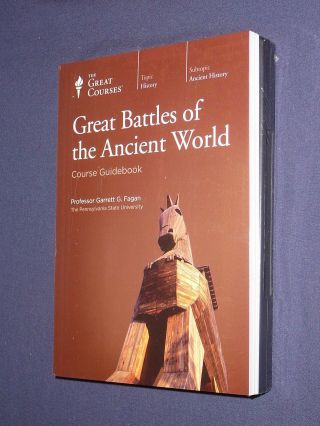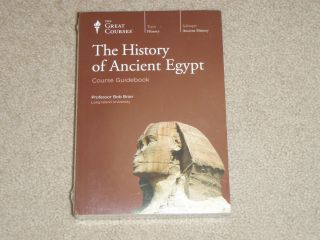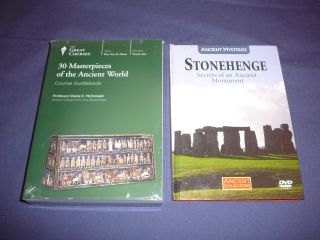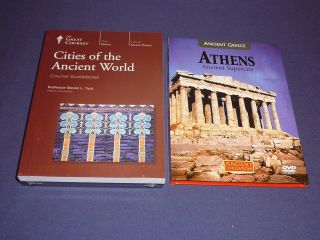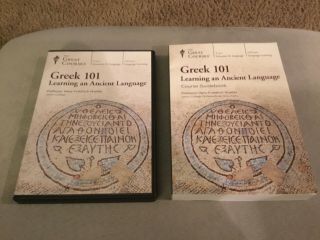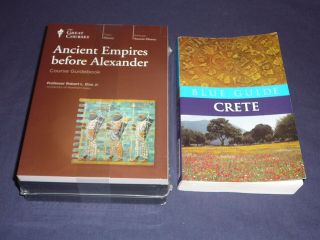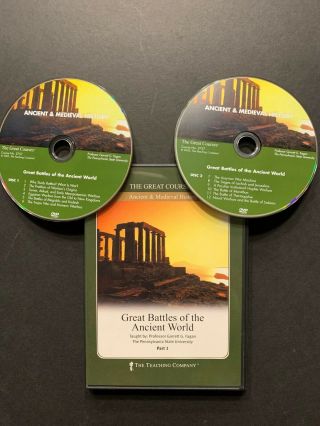Teaching Co Great Courses DVDs GREAT BATTLES Of The ANCIENT WORLD, BONUS
Item History & Price
| Reference Number: Avaluer:412359 | Format: DVD |
| Sub-Genre: War | Genre: Educational |
| Brand: Great Courses | Country/Region of Manufacture: United States |
| UPC: 9781598030501 |
( the latest release of course # 3757 )
The complete course of 24 lectures on 4 DVDs, and the guidebook.Condition: BRAND NEW, SEALED
When you buy Brand New, you know what you're getting !
As a bonus for the first buyer ( bonus offered to US residents ONLY ) I will include a mint DVD from the Ancient Civilizations series"Hannibal -- Sworn Enemy of Rome"Includes a 24-page hardco...ver book
Shipping 6 days a week
I offer combined shipping : $2 off the shipping on each additional item
About This Course 24 lectures | 30 minutes per lecture Hollywood has gone to elaborate lengths to recreate the violence and mayhem of ancient warfare in movies such as Gladiator and Troy. But what were ancient battles really like? What weapons, tactics, armor, training, and logistics were used? And what were the crucial factors that could turn the tide of battle, giving one side victory and consigning the other to slaughter, capture, or, at best, escape to fight another day?A professor of classics and history at The Pennsylvania State University and the teacher of our immensely popular course, The History of Ancient Rome, Dr. Garrett G. Fagan has devoted extensive study to ancient warfare. In these 24 lectures he takes you into the thick of combat in some of the most notable battles fought in the Mediterranean region from prehistoric times to the 4th century A.D.Great Battles—Crucibles of History "Battles, for all their madness, are worthy of study if for no other reason than that they are the crucibles of history, " says Professor Fagan, who notes that a few hours of hard fighting can determine the fates of entire empires. Among the many fateful battles you study are:Marathon: This clash between Athenians and the invading Persian army in 490 B.C.E. demonstrated the fearsome effectiveness of Greek hoplite phalanxes against Persian arms. Later European history would have looked very different had the Greeks lost at Marathon.Gaugamela: In 331 B.C.E., Alexander the Great crushed a vastly superior Persian force in a classic hammer-and-anvil battle, in which his cavalry (the hammer) outflanked the enemy to drive it onto the spear-wielding phalanx (the anvil). When the dust had settled, King Darius III was in flight, and Achaemenid Persia, which had dominated Asia for three centuries, was at an end.Masada: The Romans showed their mastery of the difficult art of siege warfare by breaching the virtually impregnable Jewish fortress of Masada, which fell on April 16, A.D. 73. The defenders took their own lives rather than surrender, ending the last chapter of the Jewish Revolt against Rome.Famous Generals You also follow celebrated confrontations between commanders of ancient times, including Hannibal versus Scipio, the 3rd-century B.C.E. equivalent of Lee versus Grant during the American Civil War, or Rommel versus Montgomery during World War II. At the head of a Carthaginian army, Hannibal nearly broke the back of Roman power in Italy, inflicting the worst Roman defeat ever at the horrendous Battle of Cannae in 218 B.C.E. But he met his match in P. Cornelius Scipio, who lured him to Africa for a killing blow at the Battle of Zama. Scipio was known ever afterward as Scipio "Africanus."Other generals you study include:Alexander the Great: Arguably the greatest general ever, Alexander was heir to the tactical innovations of his father, Philip II of Macedon, who, in turn, had learned new battle techniques from Epaminondas of Thebes. Alexander's stunning victories are marked by his maximally efficient use of military tools.Julius Caesar: A brilliant tactician and master chronicler of his own exploits, Caesar won battles against barbarian armies and Roman rivals alike. He was preparing to conquer the Parthian Empire when he was struck down in the Roman Forum on the Ides of March in 44 B.C.E.Xenophon: Elected general after the massacre of his commanding officers, this soldier of fortune led a beleaguered army of 10, 000 Greek mercenaries on a daring retreat from deep within Persian territory.What You Will Learn This course focuses on warfare in the ancient Mediterranean world, encompassing the region from Mesopotamia to Western Europe, including Egypt and North Africa.The first eight lectures chart the development of warfare from prehistoric times to the glory days of the great states of the ancient Near East and Egypt. After examining theories about how to define war, you survey different models for the origins of warfare in the Upper Paleolithic (c. 37, 000–12, 000 years ago) and Neolithic (c. 10, 000–5, 000 years ago), testing them against the archaeological evidence, which provides our only clues to organized violence among prehistoric peoples.Then you move into the historical era, starting with the first battles for which we have written accounts. These took place between the city-states of early Sumer (c. 3000–2350 B.C.E.), when armies of infantry that used rudimentary chariots clashed over honor, irrigation rights, and boundaries. Next you travel to Egypt and survey the changing nature of warfare in the Old to New Kingdoms (c. 2700–1070 B.C.E.), including the first fully recorded battle in history: the Battle of Megiddo between Pharaoh Thutmose III and a coalition of Syrian lords, fought outside the walls of a town in Palestine. You examine the fearsome Assyrian war machine as it developed c. 900–612 B.C.E., and the sophisticated army that allowed the Assyrians to forge the largest empire yet seen in the region. You also address disputed matters of the Trojan War and Homeric warfare.In the next eight lectures you cover warfare among the Greeks and their distinctive form of combat using hoplites, a type of armored infantry that fought in close formation called the phalanx. You study the Persian invasions of Greece (490–479 B.C.E.), examining the battles of Marathon, Thermopylae, Salamis, and Plataea that decided this titanic clash. The disastrous Athenian expedition against Sicily (415–413 B.C.E.) during the Peloponnesian War is next, followed by the military revolution in the 4th century B.C.E., which saw the creation of a new and formidable fighting unit spearheaded by the cavalry and a reformed phalanx. This integrated and flexible army reached its pinnacle of efficiency under Alexander the Great, and you survey the battles at the Granicus River, Issus, and Gaugamela that made Alexander king of Persia.In the third part of the course you study the legions of Rome, which evolved brutally effective tactics that gave them dominion over the entire Mediterranean basin. It is unclear how Roman legionary armies actually fought, and you explore various theories before following the legions into combat in their colossal struggles with Hannibal in the Second Punic War (218–202 B.C.E.). Then you compare the Roman legion and Macedonian phalanx—the two most efficient killing machines of the day—in duels fought in Italy in the 3rd century B.C.E. and in the Balkans and Asia Minor in the 2nd century. Next you consider Roman skill in siege warfare as exemplified by Julius Caesar's siege of Alesia (52 B.C.E.) and the siege of Masada in Judea in A.D. 72–73. The final two battles covered are Roman defeats and introduce the German tribal warrior. These are the battles of the Teutoburg Forest in A.D. 9, considered one of the most important battles in European history, and Adrianople in A.D. 378, which heralded the decline of Roman imperial power.In the final lecture, Professor Fagan considers the recent proposal by scholar Victor Davis Hanson that there is a distinctively "Western way of war" traceable from the Greeks to the modern age. This intriguing view represents hoplite warfare as a unique development of Greek conditions that casts its shadow down to the present. Despite the theory's attractive simplicity, it has problems that Dr. Fagan details in a fascinating glimpse of scholarly debate in action.Clash of Theories The battles you study were fought so long ago, and accounts of them are so incomplete, that what happened involves considerable controversy. Professor Fagan presents contending theories and often his own hypotheses about how events unfolded during these bloody encounters. For example:The standard view of battle mechanics adopted by opposing armies of Greek hoplites is that they advanced shoulder-to-shoulder in close-ordered formation and crashed into each other head-on. Then they sought, quite literally, to shove their opponents off the field, all the while stabbing with their spears. The minority view is that hoplite battle was more open, with hoplites standing up to six feet apart and fighting individually rather than as a mass. Dr. Fagan demonstrates how this minority view "is a lot more plausible and is supported by the ancient evidence better than the strange business of ritualized shoving."Similarly, it is far from clear how Roman legionaries fought their battles. The principal ancient source, the historian Livy, is so confused on the point that it is obvious he never witnessed a legion in action. After considering various schools of thought, Professor Fagan draws on clues from different battle narratives to conclude that flexibility lay at the heart of the Roman system, so that no one "battle deployment" fit all.On the issue of whether the Greek hoplites at Marathon charged the Persians across the one-mile gap separating the armies, as described by the ancient historian Herodotus, Professor Fagan notes that experiments carried out at The Pennsylvania State University with physical education majors suggest that Herodotus was wrong. Wearing weighted jackets and carrying mock nine-pound shields, only one of the Penn State athletes could run the mile-long course, and he was utterly exhausted—certainly not in a position to fight 24, 000 Persians!War's Grim Reality Dr. Fagan ends by reminding us of the grim reality of war: Throughout history many millions have died on battlefields. "We owe it to them, " he concludes, "and to the thousands who continue to perish in our planet's wars, to understand as fully as possible what it was that killed them. If this course has advanced its audience's comprehension of war even a little, then it has amply fulfilled its purpose."
24 Lectures 1 Why Study Battles? What Is War? 2 The Problem of Warfare’s Origins 3 Sumer, Akkad, and Early Mesopotamian Warfare 4 Egyptian Warfare from the Old to New Kingdoms 5 The Battles of Megiddo and Kadesh 6 The Trojan War and Homeric Warfare 7 The Assyrian War Machine 8 The Sieges of Lachish and Jerusalem 9 A Peculiar Institution? Hoplite Warfare 10 The Battle of Marathon 11 The Battle of Thermopylae 12 Naval Warfare and the Battle of Salamis 13 The Athenian Expedition to Sicily 14 The March of the Ten Thousand 15 Macedonian Military Innovations 16 Alexander’s Conquest of Persia 17 The Legions of Rome 18 The Battles of Cannae and Zama 19 Legion versus Phalanx—Six Pitched Battles 20 The Sieges of Alesia and Masada 21 Caesar’s World War 22 The Battle of the Teutoburg Forest 23 Catastrophe at Adrianople 24 Reflections on Warfare in the Ancient World



